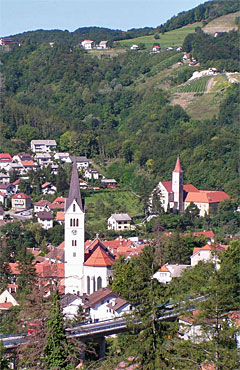Krapina
 Krapina is an 800-year old fortified town, mentioned for the first time in a written document in 1193. Mostly famous for the archeological site of the Krapina Neanderthal Man - Homo Crapiniensis. The Parish Church of St. Nicholas, the patron saint of the town, was first mentioned in 1311, but was destroyed in an earthquake in the 19th century and rebuilt over the old foundations at the turn of the century. The Church of St. Catherine and the Franciscan Monastery are more than 350 years old. In the 17th century it was a faculty of theology, philosophy, rhetorics and a very valuable library, preserved until today. It is open for visitors, as is the sacral museum. There used to be a Latin school (lower secondary education) where Ljudevit Gaj was schooled. The Baroque Church of St. Mary of Jerusalem on Trški Vrh was built by the parishioners 250 years ago. It is one of the most valuable Baroque monuments in Croatia, serving as a votive place, feast and fair site. Krapina is known to be a very interesting tourist spot. The vice-roy Josip Jelačić brought the Saxon king to Krapina in 1845, to visit this interesting place with the largest fort in this part of Croatia and the settlement around it, which had the privileges of the royal market charter since 1347. This town was also the seat of the Croatian Tribal Parish. In the 14th century it was a county, and today Krapina is the center of Krapina and Zagorje County.
Krapina is an 800-year old fortified town, mentioned for the first time in a written document in 1193. Mostly famous for the archeological site of the Krapina Neanderthal Man - Homo Crapiniensis. The Parish Church of St. Nicholas, the patron saint of the town, was first mentioned in 1311, but was destroyed in an earthquake in the 19th century and rebuilt over the old foundations at the turn of the century. The Church of St. Catherine and the Franciscan Monastery are more than 350 years old. In the 17th century it was a faculty of theology, philosophy, rhetorics and a very valuable library, preserved until today. It is open for visitors, as is the sacral museum. There used to be a Latin school (lower secondary education) where Ljudevit Gaj was schooled. The Baroque Church of St. Mary of Jerusalem on Trški Vrh was built by the parishioners 250 years ago. It is one of the most valuable Baroque monuments in Croatia, serving as a votive place, feast and fair site. Krapina is known to be a very interesting tourist spot. The vice-roy Josip Jelačić brought the Saxon king to Krapina in 1845, to visit this interesting place with the largest fort in this part of Croatia and the settlement around it, which had the privileges of the royal market charter since 1347. This town was also the seat of the Croatian Tribal Parish. In the 14th century it was a county, and today Krapina is the center of Krapina and Zagorje County.
Address: Magistratska 20, 49000 Krapina
Tel: 049 382-405, 382-400
Fax: (+385 49) 371-211
E-mail: grad.krapina@kr.htnet.hr
Web: http://www.krapina.hr
Objects on town area
Krapina Gallery
Zagorska razvojna agencija, Ltd
Church of St. Mary of Jerusalem
Franciscan Monastery and the Church of St. Catherine
Museum of Krapina Neanderthals
Tourist Board of Krapina-zagorje County
